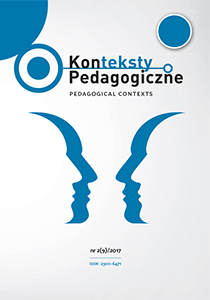Abstract
The article contains considerations on how to use nonverbal communication in order to maintain discipline during lessons or lectures. Verbal communication alone is often not enough to achieve the didactic objectives. Just like in daily communication, where the sphere of nonverbal communication is the most important part of the information transfer, in school it supports the effects of teaching and builds the teacher’s position and respect in the eyes of the students. Wise and experienced teacher skillfully uses gestures, facial expressions and other nonverbal methods in teaching and education of his or her students.
References
Adler, R.B., Rosenfeld, L.B. & Proctor, R.F. (2006). Relacje interpersonalne – proces porozumiewania się. Poznań: Rebis.
Arcimowicz, J. (1996). Metody poznawania uczniów i klasy szkolnej. Łomża: WOM.Borg, J. (2011). Język ciała. Siedem lekcji komunikacji niewerbalnej. Warszawa: Polskie Wydawnictwo Ekonomiczne.
Czerepaniak-Walczak, M. (1998). Istota i granice wolności w interakcjach edukacyjnych In: J. Jarco (ed.), Etyka, świat wartości moralnych. Podręcznik do szkół średnich (p. 126–127). Warszawa–Wrocław: PWN.
Dymek, M. (1996). Komunikacja niewerbalna też ważna. Nowa Szkoła, 3, 20–23.
Faber, A. & Mazlish, E. (1998). Jak mówić, żeby dzieci się uczyły w szkole i w domu. Poznań: Media Rodzina.
Garstka, W. (1997). Komunikacja niewerbalna a terapeutyczna rola nauczyciela. Życie Szkoły, 7,16–26.
Gaś, Z. (1997). Pomoc psychologiczna młodzieży. Warszawa: WSiP.
Gordon, T. (1998). Wychowanie bez porażek w szkole. Warszawa: Instytut Wydawniczy PAX.
Jakubowska, U. (1994). Porozumiewanie się na lekcjach. Umiejętności komunikacyjne nauczyciela. Psychologia Wychowawcza, 3,224–234.
Kacprzak, L. (2006). Związki i zależności komunikacyjne pomiędzy nauczycielem a uczniem. In: W. Maliszewski (ed.), Komunikowanie społeczne w edukacji – dyskurs nad rolą komunikowania (p. 309–315). Toruń: Adam Marszałek.
Kołodziejczyk, J. (2005). Dyscyplina w klasie. Metody i techniki interwencji. Kraków: Sophia.
Leathers, D.G. (2009). Komunikacja niewerbalna. Zasady i zastosowania. Warszawa: PWN.
Levin, J. & Nolan, J.F. (2010). Classroom Management. A Professional Decision-Making Model.Warszawa: Pearson.
Łoskot, M. (2011). Jak utrzymać dyscyplinę w klasie. Głos Pedagogiczny, 11, 48–52.
Matusewicz, C. (1979). Komunikacja niewerbalna. Przegląd zagadnień. Przegląd Psycho logiczny, 2, 319–339.
Mądry-Kupiec, M. (2015). Nauczyciel w procesie komunikacji z uczniem. In: S. Kowal & M. MądryKupiec (eds.), Przygotowanie do wykonywania zawodu nauczyciela. W stronę edukacji spersonalizowanej (p. 99–118). Kraków: ebookowo.
Morreale, S.P., Spitzberg, B.H. & Barge, J.K. (2010). Komunikacja między ludźmi – mo tywacja, wiedza i umiejętności. Warszawa: PWN.
Niemierko, B. (1997). O powodzeniu nauczyciela w pracy dydaktyczno-wychowawczej. Warszawa: WSiP.
Nolting, H.P. (2004). Jak zachować porządek w klasie. Gdańsk: Gdańskie Wydawnictwo Psychologiczne.
Palka, S. (2008). Dialog w dydaktyce ogólnej i praktyce kształcenia. In: A. Karpińska (ed.), Teoria i praktyka kształcenia w dialogu i perspektywie (p. 38–44). Białystok: Trans Humana.
Pease, A. (1995). Język ciała. Jak czytać myśli ludzi z ich gestów. Kraków: Gemini.
Perrott, E. (1995). Efektywne nauczanie. Warszawa: WSiP.
Wosiński, M. (1978). Współdziałanie nauczyciela z uczniami. Kształtowanie struktury interakcji między nauczycielem a uczniami. Katowice: Uniwersytet Śląski.
Zaręba, E. (1994). Społeczne ramy edukacji wczesnoszkolnej. In: S. Palka (ed.), Teoretyczne odniesienia i praktyczne rozwiązywania w pedagogice wczesnoszkolnej (p. 101–106). Katowice: Śląsk Sp. z o.o.
In accordance with the recommendation of the Ministry of Science and Higher Education, which aims to counteract the practice of “ghostwriting” and “guest authorship,” all authors submitting their text for publication should attach an author’s statement which declares the contribution of each of the authors to the article. The printed and signed statement should be delivered by mail or other means to editor-in-chief Joanna Skibska or sent in the form of a scan to the following e-mail address: redakcja@kontekstypedagogczne.pl. The authors will not receive remuneration for publishing their papers. The editors reserve the right to make minor editorial changes to the articles which will not affect the substance of the article. We encourage all authors to prepare their articles in accordance with the guidelines for manuscript preparation. Download pdf file.
Authors transfer all copyrights and grant the journal the right of first publication with the work simultaneously licensed under a Creative Commons Attribution License that allows others to share the work with acknowledgement of the work's authorship and initial publication in this journal. All authors agree to the publishing of their email addresses, affiliations and short bio statements with their articles during the submission process.

